Sustainable Agriculture Research and Education Regional Host Institution
NIFA is seeking applications from eligible institutions interested in serving the Sustainable Agriculture Research and Education (SARE) program as either a Regional Host Institution (one in each of the four regions) or as the program’s National Reporting, Coordinating and Communications Office (NRCCO). Selected institutions are expected to serve in the role for fiscal years 2023 through 2032. The Request for Applications can be downloaded from the NIFA website. Interested parties can also go to the national SARE website for specific information about current national and regional SARE grant programs and resources.
NIFA Invests $9M in Crop Protection and Pest Management Program
NIFA has invested $9 million in the Crop Protection and Pest Management (CPPM) Program, which addresses critical state, regional and national integrated pest management (IPM) needs to ensure food security and respond effectively to other major societal pest management challenges. The CPPM program supports projects that address these challenges with IPM approaches developed by coordinated state, regional, and national research, and extension efforts. In FY 2022, NIFA funded 20 projects in the Applied Research and Development Program area, and four projects in the Regional Coordination Program area of the CPPM program.
NIFA Invests Nearly $6M in Biotechnology Risk Assessment Research Program
NIFA has invested nearly $6 million in the Biotechnology Risk Assessment Grants (BRAG) program, which supports the development of new information that will assist federal regulatory agencies in making evidence-based decisions about the effects of genetically engineered organisms on the environment. This program supports investigations of managed and natural environments across a wide breadth of organisms. This year, BRAG supported 12 research awards and one conference award. BRAG is co-administered by the Agricultural Research Service (ARS) and jointly funded by USDA-NIFA, USDA-ARS and USDA-Forest Service.
NIFA Invests $4.8M in Community Food Projects
NIFA has invested $4.8 million in 22 projects as part of the Community Food Projects Competitive Grant Program (CFPCGP), which works to meet the food needs of low-income individuals through food distribution, community outreach to assist in participation in federally assisted nutrition programs, or improve access to food as part of a comprehensive service. CFPCGP aims at increasing the self-reliance of communities in providing for the food needs of the communities; and promoting comprehensive responses to local food access, farm, and nutrition issues. CFPCGP projects are designed to meet specific state, tribal, local or neighborhood food and agricultural needs. Funded projects demonstrate alignment between communities in need and innovative practices to increase in food access, marketing and distribution opportunities, and sustainably reduce food and nutrition insecurity.
NIFA Invests Over $3M in Alfalfa Seed and Alfalfa Forage System
NIFA has invested over $3 million in five awards as part of the Alfalfa Seed and Alfalfa Forage System Program, which supports the development of improved alfalfa forage and seed production systems. The projects selected for funding this year support one or more of ASAFS’ priorities: increase alfalfa forage and seed yields and forage quality through improved management practices, plant breeding, and other strategies to reduce biotic and abiotic stresses and costs of production; improve alfalfa forage and seed harvest and storage systems, including automation that reduces labor costs, to optimize economic returns to alfalfa producers as well as end users including milk producers; develop methods to estimate alfalfa forage yield and quality to support marketing as a livestock feed and instruments to reduce producer risks; explore new uses for alfalfa such as in fish feeds, nutritive supplements, alternative protein sources for human consumption, high-value chemical manufacturing, or other novel uses; develop improved insect, disease and weed management strategies, including spotted aphid in alfalfa seed production and potential herbicide carry-over issues; and document the contribution of alfalfa production systems to climate-smart agriculture, including the sequestration of carbon.
Correct Links: NIFA Invests $3.2 Million in Rural Food Animal Veterinary Medicine Across the U.S.
Due to a technical issue, incorrect links appeared last week related to this award announcement. The correct links can be found here.
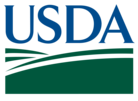
USDA Announces the Second Food Loss and Waste Innovation Fair
The U.S. Department of Agriculture will hold the second virtual USDA Food Loss and Waste Innovation Fair Sept. 14 from 10 a.m. to 2 p.m. EDT. The fair will showcase the latest food loss and waste mitigation technologies, innovations and programs developed by USDA, academic institutions, local governments and businesses.
USDA graphic symbol.
|

New EXCITE Programming Opportunity
EXCITE has launched a new phase of programming opportunities to support adult immunization education beyond COVID-19 and increase vaccine confidence in Land-grant University Extension communities. This opportunity is open to all institutions, even those not currently involved with an EXCITE project. Anyone interested in participating or learning more about this opportunity is invited to the project introduction session Sept. 22 at 3 p.m. EDT. The project's elements, timelines and goals will be covered in this introductory session, and questions will be answered. Registration required.
|
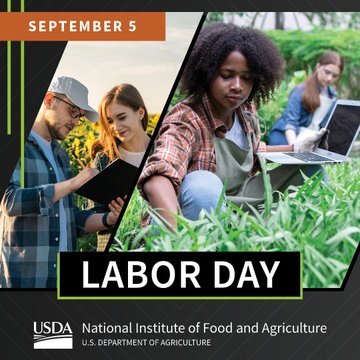
USDA NIFA Preparing Next Generation of Agricultural Workforce
Observed the first Monday in September, Labor Day is an annual celebration of the social and economic achievements of American workers. According to the U.S. Department of Labor, the holiday is rooted in the late 19th century, when labor activists pushed for a federal holiday to recognize the many contributions workers have made to America’s strength, prosperity and well-being. At NIFA, recognizing the contributions of not only employees but the people served by the agency is paramount. That is why, under Agriculture Secretary Vilsack’s leadership and the Biden-Harris Administration, USDA is empowering people and improving lives by prioritizing such goals as making the USDA a great place to work for its employees and advancing racial justice, equity, opportunity and rural prosperity. Preparing the next generation of the agricultural workforce is a prime example of these goals in action, and a new NIFA initiative is doing just that.
Labor Day graphic, courtesy of NIFA.
Read more about the impacts of NIFA-funded research and Extension programs on our Blogs page.
|
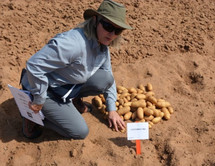
Texas A&M Potato Breeding Program Targets French Fry, Chipping, Fresh Markets
New potato varieties bred by the Texas A&M Potato Breeding Program with support from NIFA could enter the french fry market before long, said Isabel Vales, Ph.D., Texas A&M AgriLife potato breeder. “We are quite excited about a light russet experimental potato clone that has a very special feature: a high percentage of starch and high gravity even under the very stressful high-temperature conditions in Texas,” Vales said. “I think the french fry processing market, for which Texas has not released any processing russets, is a possibility.”
Isabel Vales, Ph.D., Texas A&M AgriLife potato breeder, shows off the experimental clone COTX08063-2Ru, which could be selected to make french fries,
courtesy of Texas A&M AgriLife’s Kay Ledbetter.
|
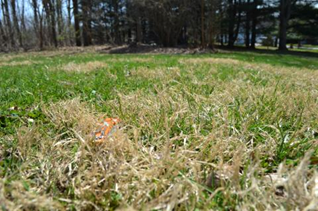
Grassy Weeds Becoming More Common in Lawns
When confronted with lawn weeds, typically we think of dandelion, creeping Charlie and violet. These plants and many others are classified as broadleaved weeds, or dicots, and are easily distinguished from grasses which are monocots. Scientists have engineered herbicides that target broadleaved plants, while the chemical does not affect desirable turfgrass. But what happens when you have a grassy weed appear in your lawn? Selective lawn herbicides containing 2, 4-D or dicamba are useful in controlling broadleaves, but will not work on grasses, according to the University of Illinois Extension, which is supported by NIFA. Annual grasses, such as crabgrass, are best controlled with a preemergent herbicide applied before the offending weeds germinate. Once the seed has germinated, a homeowner should practice good lawn care culture that can make a lawn more competitive with the weeds.
Perennial grassy weeds like quackgrass or nimblewill are becoming more common in home lawns, courtesy of University of Illinois Urbana-Champaign’s Chris Enroth.
|
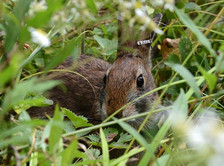
Cohabitating with New England Cottontails
The New England cottontail requires habitats of shrublands and young forests with dense understories and thick brush, where it can easily escape from predators, build nests and find its preferred diet of grasses and flowering plants and shrubs. Ongoing habitat restoration efforts will help the survival of the New England cottontail, and new NIFA-funded research by the New Hampshire Agricultural Experiment Station researchers at the University of New Hampshire finds that these efforts will have far-reaching benefits to shrubland-obligate birds with which the cottontail shares its habitat.
A New England Cottontail hiding in its natural shrubland habitat,
courtesy of the U.S. Department of the Interior.
|
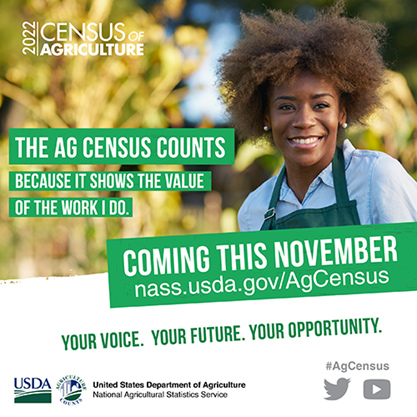
Census of Agriculture Coming This November
America’s farmers and ranchers will soon have the opportunity to be represented in the nation’s only comprehensive and impartial agriculture data for every state, county and territory. USDA will mail the 2022 Census of Agriculture to millions of agriculture producers across the 50 states and Puerto Rico this fall. Collected in service to American agriculture since 1840 and now conducted every five years by USDA’s National Agricultural Statistics Service (NASS), the Census of Agriculture tells the story and shows the value of U.S. agriculture. It highlights land use and ownership, producer characteristics, production practices, income and expenditures, among other topics. Changes to the 2022 questionnaire include new questions about the use of precision agriculture, hemp production, hair sheep, and updates to internet access questions.
Ag Census Counts graphic, courtesy of NASS.
|
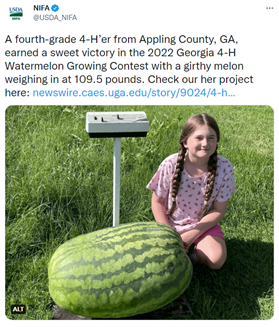
A fourth-grade 4-H’er from Appling County, Georgia, earned a sweet victory in the 2022 Georgia 4-H Watermelon Growing Contest with a girthy melon weighing in at 109.5 pounds.
|

Meet Linda Cambron
Linda serves as the capacity branch chief for NIFA's Awards Management Division. "NIFA provided the perfect opportunity to expand my career from the local to national level. Knowing my work would have a much larger impact than I was having locally was extremely rewarding to me." – Linda
|
|